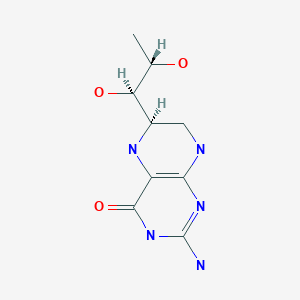Attribution Statement: LactMed is a registered trademark of the U.S. Department of Health and Human Services.
NCBI Bookshelf. A service of the National Library of Medicine, National Institutes of Health.
Drugs and Lactation Database (LactMed®) [Internet]. Bethesda (MD): National Institute of Child Health and Human Development; 2006-.
CASRN: 62989-33-7

Drug Levels and Effects
Summary of Use during Lactation
Sapropterin is a synthetic form of the naturally occurring enzyme cofactor tetrahydrobiopterin (BH4) and is used in the treatment of phenylketonuria. BH4 is found in normal human milk and is a cofactor in multiple reactions including serving as a catalyst to phenylalanine hydroxylase. In two postmarketing pregnancy registries of women taking sapropterin, a total of 16 women were identified as breastfeeding for a mean of 3.5 months. No lactation-related safety concerns were reported in infants of mothers nursing during maternal treatment with sapropterin. United States and European guidelines state that sapropterin dihydrochloride supplementation is not contraindicated as an adjunct to dietary therapy in breastfeeding women who are responsive to BH4.[1,2]
Drug Levels
Maternal Levels. Breastmilk was obtained from 10 women, colostrum from 9 and mature milk from 6. Colostrum levels of BH4 averaged about 100 nmol/L (241 mcg/L) and mature milk levels averaged about 500 nmol/L (1200 mcg/L). The difference between colostrum and mature milk was statistically significant.[3]
Three mothers who were taking sapropterin for phenylketonuria had breastmilk samples taken at times that were not reported. Their milk BH4 levels were greater than reported in normal human milk, but specific values were not reported.[4]
Infant Levels. Relevant published information was not found as of the revision date.
Effects in Breastfed Infants
A Japanese woman with phenylketonuria took sapropterin dihydrochloride 500 mg (10 mg/kg) daily during pregnancy and postpartum. She breastfed her infant (extent not stated) until 25 months of age. The infant had normal developmental milestones and normal growth at 31 months of age.[5]
Effects on Lactation and Breastmilk
Relevant published information was not found as of the revision date.
References
- 1.
- Management of women with phenylalanine hydroxylase deficiency (phenylketonuria): ACOG Committee Opinion, Number 802. Obstet Gynecol. 2020;135:e167–e70. [PubMed: 32217978]
- 2.
- van Wegberg AMJ, MacDonald A, Ahring K, et al. The complete European guidelines on phenylketonuria: Diagnosis and treatment. Orphanet J Rare Dis. 2017;12:162. [PMC free article: PMC5639803] [PubMed: 29025426]
- 3.
- Weinmann A, Post M, Pan J, et al. Tetrahydrobiopterin is present in high quantity in human milk and has a vasorelaxing effect on newborn rat mesenteric arteries. Pediatr Res. 2011;69:325–9. [PubMed: 21178821]
- 4.
- Hillman R, Peck D, Grange DK, et al. Breast milk and plasma pterin levels and offspring outcomes of 25 pregnancies in women exposed to sapropterin dihydrochloride prior to or during pregnancy: An interim report of the PKU moms sub-registry. J Inherit Metab Dis 2013;36:S120. Abstract P-018. doi: 10.1007/s10545-013-9633-z. [CrossRef]
- 5.
- Nyuzuki H, Yamazaki T, Saito M, et al. First Japanese case of maternal phenylketonuria treated with sapropterin dihydrochloride and the normal growth and development of the child. Mol Genet Metab Rep. 2019;21:100526. [PMC free article: PMC6839020] [PubMed: 31720228]
Substance Identification
Substance Name
Sapropterin
CAS Registry Number
62989-33-7
Disclaimer: Information presented in this database is not meant as a substitute for professional judgment. You should consult your healthcare provider for breastfeeding advice related to your particular situation. The U.S. government does not warrant or assume any liability or responsibility for the accuracy or completeness of the information on this Site.
- User and Medical Advice Disclaimer
- Drugs and Lactation Database (LactMed) - Record Format
- LactMed - Database Creation and Peer Review Process
- Fact Sheet. Drugs and Lactation Database (LactMed)
- Drugs and Lactation Database (LactMed) - Glossary
- LactMed Selected References
- Drugs and Lactation Database (LactMed) - About Dietary Supplements
- Breastfeeding Links
- PMCPubMed Central citations
- PubChem SubstanceRelated PubChem Substances
- PubMedLinks to PubMed
- Review International best practice for the evaluation of responsiveness to sapropterin dihydrochloride in patients with phenylketonuria.[Mol Genet Metab. 2019]Review International best practice for the evaluation of responsiveness to sapropterin dihydrochloride in patients with phenylketonuria.Muntau AC, Adams DJ, Bélanger-Quintana A, Bushueva TV, Cerone R, Chien YH, Chiesa A, Coşkun T, de Las Heras J, Feillet F, et al. Mol Genet Metab. 2019 May; 127(1):1-11. Epub 2019 Apr 26.
- Review Sapropterin dihydrochloride (Kuvan/phenoptin), an orally active synthetic form of BH4 for the treatment of phenylketonuria.[IDrugs. 2007]Review Sapropterin dihydrochloride (Kuvan/phenoptin), an orally active synthetic form of BH4 for the treatment of phenylketonuria.Burnett JR. IDrugs. 2007 Nov; 10(11):805-13.
- Review Sapropterin: a review of its use in the treatment of primary hyperphenylalaninaemia.[Drugs. 2009]Review Sapropterin: a review of its use in the treatment of primary hyperphenylalaninaemia.Sanford M, Keating GM. Drugs. 2009; 69(4):461-76.
- Long-term efficacy and safety of sapropterin in patients who initiated sapropterin at < 4 years of age with phenylketonuria: results of the 3-year extension of the SPARK open-label, multicentre, randomised phase IIIb trial.[Orphanet J Rare Dis. 2021]Long-term efficacy and safety of sapropterin in patients who initiated sapropterin at < 4 years of age with phenylketonuria: results of the 3-year extension of the SPARK open-label, multicentre, randomised phase IIIb trial.Muntau AC, Burlina A, Eyskens F, Freisinger P, Leuzzi V, Sivri HS, Gramer G, Pazdírková R, Cleary M, Lotz-Havla AS, et al. Orphanet J Rare Dis. 2021 Aug 3; 16(1):341. Epub 2021 Aug 3.
- Review Sapropterin dihydrochloride, 6-R-L-erythro-5,6,7,8-tetrahydrobiopterin, in the treatment of phenylketonuria.[Expert Opin Investig Drugs. 2008]Review Sapropterin dihydrochloride, 6-R-L-erythro-5,6,7,8-tetrahydrobiopterin, in the treatment of phenylketonuria.Michals-Matalon K. Expert Opin Investig Drugs. 2008 Feb; 17(2):245-51.
- Sapropterin - Drugs and Lactation Database (LactMed®)Sapropterin - Drugs and Lactation Database (LactMed®)
Your browsing activity is empty.
Activity recording is turned off.
See more...
